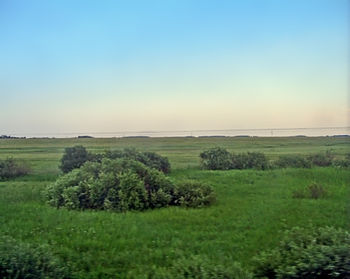West Siberian Plain

The West Siberian Plain (Template:Lang-ru) is a large plain that occupies the western portion of Siberia and Russia, between the Ural Mountains in the west and the Yenisei River in the east, and by the Eastern Sayan Mountains[dubious – discuss] and the Baikal Mountains[dubious – discuss] on the south. Much of the plain is poorly drained and consists of some of the world's largest swamps and floodplains. Important cities include Omsk and Chelyabinsk, which are located near the Urals in a rich coal-mining region.
Geography
West Siberian Plain is located east of Ural Mountains. It covers an area of more than 975,000 sq.mi. It has been described as the world's largest unbroken lowland—more than 50 percent is less than 330 feet (100 m) above sea level[1]—and covers an area of about 2.6–2.7 million km² which is about one third of Siberia,[2] extending from north to south for 2,400 km, from the Arctic Ocean to the foothills of the Altay Mountains, and from west to east for 1,900 km from the Yenisei River to the Ural Mountains.
The plain has eight distinct vegetation regions: tundra, forest-tundra, northern taiga, middle taiga, southern taiga, sub-taiga forest, forest-steppe, and steppe. The number of animal species in the West Siberian Plain ranges from at least 107 in the tundra to 278 or more in the forest-steppe region. The long Yenisey river flows broadly south to north, a distance of 2,195 mi., where it completes its journey, discharging more than 5 million gallons of water per second. Together with its tributary Angara, the two rivers flow 3,435 mi. The valley it has formed acts as a rough dividing line between the West Siberian Plain and the Central Siberian Plateau. Glacial deposits extend as far south as the Ob-Irtysh confluence, forming occasional low hills and ridges, but otherwise the plain is exceedingly flat and featureless.
Winters on the West Siberian Plain are harsh and long. The climate of most of the plains is either subarctic or continental. Two of the larger cities on the plain are Surgut and Nizhnevartovsk.
Geology
The West Siberian Plain consists mostly of Cenozoic alluvial deposits and is extraordinarily flat. A rise of fifty metres in sea level would cause all land between the Arctic Ocean and Novosibirsk to be inundated (see also Turgai Straits, West Siberian Glacial Lake). It is a region of the Earth's crust that has undergone prolonged subsidence and is composed of horizontal deposits from as much as 65,000,000 years ago. Many of the deposits on this plain result from ice dams; having reversed the flow of the Ob and Yenisei Rivers, redirecting them into the Caspian Sea, and perhaps the Aral Sea as well. It is very swampy and soils are mostly peaty Histosols and, in the treeless northern part, Histels.
It is one of the world's largest areas of peatlands, which are characterized by raised bogs. It is believed that the world’s largest single raised bog is at Vasuganskoe, covering approximately 51,600 km².
In the south of the plain, where permafrost is largely absent, rich grasslands that are an extension of the Kazakh Steppe formed the original vegetation (almost all cleared now).
Large regions of the plains are flooded in the spring, and marshlands make much of the area unsuitable for agriculture. The principal rivers in the West Siberian Plain are the Ob, Irtysh, and Yenisei. There are many lakes and swamps, as well as large petroleum and natural gas reserves. Most of the Russia's oil and gas production was extracted from this area during the 1970s and 80s.[2]
See also
- East European Plain, the other major plain of Russia
- Eurasian steppe
References
- ^ "Russia". Encyclopedia Britannica. Retrieved 2006-10-24.
- ^ a b "Western Siberian Plain". Columbia Encyclopedia. Retrieved 2006-10-24.
External links

